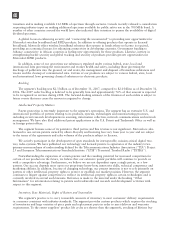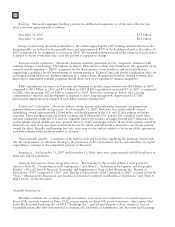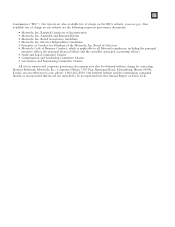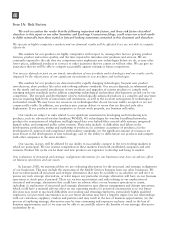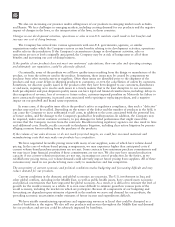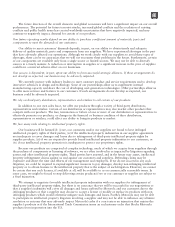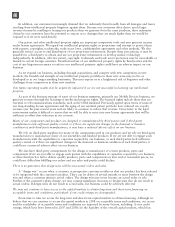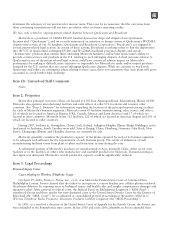Motorola 2007 Annual Report Download - page 30
Download and view the complete annual report
Please find page 30 of the 2007 Motorola annual report below. You can navigate through the pages in the report by either clicking on the pages listed below, or by using the keyword search tool below to find specific information within the annual report.
In addition, our customers increasingly demand that we indemnify them broadly from all damages and losses
resulting from intellectual property litigation against them. Because our customers often derive much larger
revenue streams by reselling or leasing our products than we generate from the same products, these indemnity
claims by our customers have the potential to expose us to damages that are much higher than we would be
exposed to if we were sued directly.
Our patent and other intellectual property rights are important competitive tools and may generate income
under license agreements. We regard our intellectual property rights as proprietary and attempt to protect them
with patents, copyrights, trademarks, trade secret laws, confidentiality agreements and other methods. We also
generally restrict access to and distribution of our proprietary information. Despite these precautions, it may be
possible for a third party to obtain and use our proprietary information or develop similar technology
independently. In addition, effective patent, copyright, trademark and trade secret protection may be unavailable or
limited in certain foreign countries. Unauthorized use of our intellectual property rights by third parties and the
cost of any litigation necessary to enforce our intellectual property rights could have an adverse impact on our
business.
As we expand our business, including through acquisitions, and compete with new competitors in new
markets, the breadth and strength of our intellectual property portfolio in those new areas may not be as
developed as in our longer-standing businesses. This may expose us to a heightened risk of litigation and other
challenges from competitors in these new markets.
Our future operating results may be negatively impacted if we are not successful in licensing our intellectual
property.
As part of the business strategy of some of our business segments, primarily our Mobile Devices business, we
generate revenue through the licensing of intellectual property rights. The licensed rights include those that are
essential to telecommunications standards, such as the GSM standard. Previously agreed-upon terms of some of
our long-standing license agreements and the aging of our essential patent portfolio have reduced our royalty
revenue over the past several years and are likely to continue to reduce that revenue. Uncertainty in the legal
environment makes it difficult to assure that we will be able to enter into new license agreements that will be
sufficient to offset that reduction in our revenue.
Many of our components and products are designed or manufactured by third parties and if third-party
manufacturers lack sufficient quality control or if there are significant changes in the financial or business
condition of such third-party manufacturers, it may have a material adverse effect on our business.
We rely on third-party suppliers for many of the components used in our products and we rely on third-party
manufacturers to manufacture many of our assemblies and finished products. If we are not able to engage such
manufacturers with the capabilities or capacities required by our business, or such third parties lack sufficient
quality control or if there are significant changes in the financial or business condition of such third parties, it
could have a material adverse effect on our business.
We also have third-party arrangements for the design or manufacture of certain products, parts and
components. If we are not able to engage such parties with the capabilities or capacities required by our business,
or these third parties fail to deliver quality products, parts and components on time and at reasonable prices, we
could have difficulties fulfilling our orders and our sales and profits could decline.
There is no guarantee that design wins will become actual orders and sales.
A “design win” occurs when a customer or prospective customer notifies us that our product has been selected
to be integrated with the customer’s product. There can be delays of several months or more between the design
win and when a customer initiates actual orders. The design win may never become an actual order or sale.
Further, if the customer’s plans change, we may commit significant resources to design wins that do not result in
actual orders. If design wins do not result in actual sales, our business could be adversely affected.
We may not continue to have access to the capital markets to obtain long-term and short-term financing on
acceptable terms and conditions, particularly if our credit ratings are downgraded.
From time to time we access the long-term and short-term capital markets to obtain financing. Although we
believe that we can continue to access the capital markets in 2008 on acceptable terms and conditions, our access
and the availability of acceptable terms and conditions are impacted by many factors, including: (i) our credit
ratings, which have been lowered in 2007 and 2008; (ii) the liquidity of the overall capital markets, which has
22




